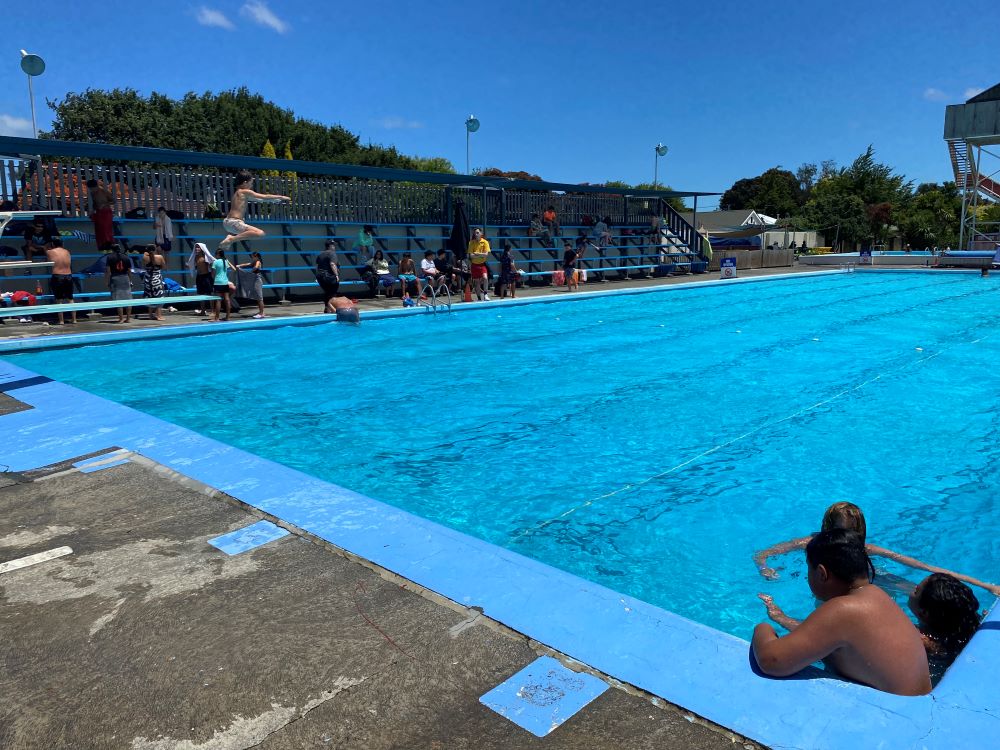
By Moana Ellis, Local Democracy Reporting
Upgrade Whanganui East Pool and develop the Splash Centre, or get rid of the pool in favour of expanding the city’s aquatic complex?
Those are the two options put forward by Whanganui’s first citizens’ assembly for the future of the district’s outdoor swimming facilities.
Councillors will make a decision at the next council meeting on Tuesday, 12 August.
Council officers are recommending the council approve one of the two recommendations provided by the citizens’ assembly.
It could reject both but officers warn that could undermine public confidence in the council’s commitment to participatory democracy.
Whanganui District Council heard recommendations from a small number of participants of the 39-person assembly at a livestreamed meeting this week.
The citizens’ assembly process brought together locals selected to reflect a cross-section of Whanganui’s population, including representation from Māori, younger residents and those living in Whanganui East.
The group worked through a facilitated process over more than five weeks to arrive at the two options.
The first recommendation to upgrade both the Whanganui East Pool and the Splash Centre would aim to extend the pool’s life by at least 25 years, the assembly said.
Improvements could include heating the pool to allow a longer season, refurbishing changing and family rooms with accessibility features like a hydraulic lift, deepening the pool, reinstating the diving board and upgrading the hydro-slide.
52m indoor pool
Upgrades to the Splash Centre could include adding a 52-metre multi-use indoor pool with an adjustable floor, or enlarging the existing 25m pool to enable aqua-jogging. Also suggested was a bombing platform or diving board and more hydro-therapy pools.
The second option – closing or disposing of the Whanganui East Pool but expanding the Splash Centre – would focus on making the aquatics centre adaptable for water sports. This recommendation proposes ending council ownership of the Whanganui East Pool, with funding to cease after the 2025/26 season.
The long-term plan 2024/2034 decision was to keep the Whanganui East Pool open for the 2024/25 summer season while the council investigated options. The Whanganui Aquatics Network Plan was commissioned and funding of $2 million was tagged to outdoor swimming.
Both recommendations would require significant capital investment.
The assembly said the plan gave indicative capital spend costings of $2.5m-$3m for upgrading both the pool and the Splash Centre, and $6m-$9m for expanding the aquatics centre to include outdoor facilities, but closing or disposing of the Whanganui East Pool.
Indicative costs for an indoor expansion of Splash Centre facilities was $15m-$20m.
‘Pivotal role’
Council chief executive David Langford said the goal of the citizens’ assembly was to get the community deeply involved at the outset of a decision, rather than backloading engagement to the end of the process by surveying the community once recommendations had been developed.
He said the assembly had been a success, with the group playing a pivotal role in an important community decision.
“The two options presented show the calibre of their discussions and reflect the diverse values, perspectives and priorities of our community.”
Langford said reaching the end of the citizens’ assembly process was the culmination of a landmark engagement process for the council.
“We’ve tried a new way of involving the community in complex decisions and it has worked.
“From 367 expressions of interest, the group was selected at random to reflect our district’s demographics. They brought their lived experience and insights to the table and navigated complex ideas together. The council is grateful for their contribution.”
The democracy experiment was kept under wraps, with assembly meetings held behind closed doors. The 39 were to be paid $500 each to come up with recommendations for the council.
The council kept secret the identities of the residents selected for the assembly, and there was no public access to the five meetings.
In May, the council declined to reveal the names of assembly members to protect privacy and “members, officers, employees and persons from improper pressure or harassment”.
The council said it feared publishing names would discourage future participation in similar processes.
Awa FM – Te Reo Irirangi o Whanganui
For more of our people, our stories, our way, click News or follow us on Facebook.
